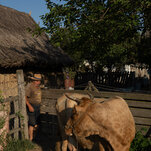
After Russian Attack in Ukraine, Broken Glass and Rattled Nerves in Romania

A drone assault on a Danube River port sent shock waves — both the physical and the psychological kind — into villages just across the water that are in NATO territory.


By Andrew Higgins
Andrew Higgins traveled by boat and road to Plauru, Romania, to report this story.
His thatched-roof shack on the bank of the Danube River just 200 yards from Ukraine has no running water, and getting to it involves waiting for a ferry and a bumpy ride on dirt roads.
Last week, however, the farmyard home of Gheorge Puflea, 71, became a piece of attention-grabbing real estate thanks to its unwanted status as the first property in NATO territory damaged in a Russian attack aimed at Ukraine.
The drone missile assault, carried out before dawnlast Wednesday, hit a Ukrainian cargo port across the river, but it was so close that shock waves from the explosions shattered windows in Plauru, a tiny hamlet with just a dozen tumbledown homes on the Romanian side of the Danube.
The sound of the blasts and breaking glass woke Mr. Puflea from his sleep and sent him rushing outside in a panic to see what was going on.
“At first I thought it was a thunderstorm,” he said, recalling how he had taken shelter under a pear tree in his yard and then watched in horror as “what looked like a war movie played out right on my doorstep.”
Image
The night sky crackled with Ukrainian antiaircraft fire and huge fireballs rose from three Ukrainian port buildings blasted by Russian drones. A week earlier Russia had attacked Reni, another Ukrainian port across the Danube from Romania.
The Russian attacks were aimed at severing what has been a shipping lifeline provided to Ukraine by river ports, ever since the collapse last month of a deal that had allowed Ukraine to export its grain through the Black Sea despite a naval blockade by Russia. With Ukraine’s seaports too dangerous for grain-carrying vessels bound for the Middle East and Africa, its ports on the Danube have become the last shipping outlet for millions of tons of grain.
Its main Danube ports — Izmail and Reni — have also become a potentially perilous tripwire, as they lie so close to Romania, a member of NATO, and therefore to territory covered by the alliance’s commitment to collective security. A Russian drone or missile flying a few yards off course would risk dragging the United States and its allies into a direct military confrontation with Moscow.
The last time fears spiked that NATO was under Russian attack was in November when a missile that Ukraine insisted was Russian landed in a Polish village a few miles from the Ukrainian border and killed two Poles. But it turned out to be a Ukrainian air defense missile, so fears of a wider war quickly dissipated.
The Romanian episodes, however, still have nerves on edge. On Saturday, three days after the drone attack on Izmail, air raid sirens again wailed on the Ukrainian side of the river. No attack came, but the din of the sirens, clearly audible across the Danube in Plauru, convinced some Romanian villagers they were living in a war zone.
Daniela Tanase, 44, who lives with her son and husband at the end of the village, said the sirens had woken her family at 6 a.m. The village is indisputably part of Romania, she said, but the drone attack left her feeling “as if we are over there” in Ukraine.
Image
The residents do not think Russia has any designs on their isolated patch of Romania, not least because the village has so little for Russia to covet. “It is like the Middle Ages here — no clean water, no shops and no roads,” said Marin Stoian, a retiree who moved to Plauru for the summer to be with his second wife, a 71-year-old local. “There is nothing here for Russia or for NATO,” he said.
Whatever either side’s intentions, however, the risk of miscalculation is terrifying.
Preparing for possible trouble on the Danube has long been part of annual NATO military exercises in Romania. Their most recent iteration in June featured U.S. and Romanian troops crossing a section of the river to test what the alliance described as “their ability to move rapidly through difficult terrain during military operations.”
“We are part of NATO and should not be in any danger from Russia, but there could easily be an accident at any moment. Our bank of the river is just a few meters from Ukraine,” said Teodosie Gabriel Marinov, governor of the Danube Delta Biosphere Reserve Authority, a government agency responsible for the Romanian portion of a vast wetland area straddling the border between Romania and Ukraine.
“We can all now see that anything could happen,” Mr. Marinov said last week in an interview in his office in Tulcea, the regional capital. His window offered a jolting view of pleasure boats packed with tourists heading into the delta, huge cargo ships heading upstream to pick up Ukrainian grain and, in the distance, thick plumes of black smoke rising from port facilities in Izmail set alight by Russian drones.
Image
“Unfortunately priorities at the moment are not related to environmental protection,” said Mr. Marinov, the biosphere governor, adding that he had not met with his Ukrainian counterpart for months because Ukraine’s part of the delta is no longer managed by officials concerned about protecting birds and fish, but by the military.
For a few tense hours last Wednesday it seemed as if Russia had crossed a previously inviolable red line between Ukrainian and NATO territory. Ms. Tanase’s son Marius, a fisherman, told the mayor of a cluster of Danube delta villages that he had seen at least one Russian drone fly directly over the family house before veering out of Romanian airspace to strike Izmail. One drone, another villager reported, had landed in a forest in Romania.
The mayor, Tudor Cernega, passed on the fisherman’s story to a Romanian television station, which promptly reported that Russian drones had entered Romania. By afternoon, media pundits and experts were anxiously discussing whether Romania and therefore NATO were under attack.
Image
Mr. Cernega said the state of alarm was so intense that the local Orthodox priest fled with his family by ferry to the nearest town.
“It is amusing now but at the time it was terrifying,” he said. “We all had the impression we had been abandoned.”
The Romanian air force rushed a team of experts to Plauru to investigate. The defense ministry, in a statement, reported that it found no sign of any Russian drone landing in the forest or any violations of Romanian airspace.
That and the knowledge that NATO has a big air base just 50 miles away near the Black Sea port of Constanta has mostly calmed worries in Plauru and other villages that Russia might risk a deliberate strike.
Image
Petrut Pascu, 36, a truck driver who spends much of his time away from home working in Ireland and Britain, said he and his wife recently bought a house in a village near Plauru and, since the attack on Izmail port, had talked about selling it. His wife, he said, wants to move away, but he sees no real risk. “I think we are safe,” he said. “But we never expected to be so close to this war in Ukraine.”
The fisherman, Mr. Tanase, is sticking to his story, insisting that he heard a drone buzzing directly over his family’s home in Plauru. His mother, Daniela, also questions the official version of events. She said the deafening noise of drones panicked the family cow, which broke its rope tether and ran away, along with her pet cat.
“The Defense Ministry said the drones were not on our territory but I don’t believe them,” she said. Ukraine, she added, “is just 200 meters away.”
In some places along the Danube, the distance is even less but is difficult to calculate because the border has shifted as the river has changed its course.
On his office computer, Mr. Cernega, the district head, downloaded an official map that identified forest and farmland he always considered part of his district as lying inside Ukraine.
“I need to know where the border really is,” he said. “The defense ministry should tell me. Otherwise, 2 + 2 is not 4 but 6. It is very dangerous if we don’t know which country we are in.”
Image
Delia Marinescu contributed reporting.
Andrew Higgins is the bureau chief for East and Central Europe based in Warsaw. Previously a correspondent and bureau chief in Moscow for The Times, he was on the team awarded the 2017 Pulitzer Prize in International Reporting, and led a team that won the same prize in 1999 while he was Moscow bureau chief for The Wall Street Journal. More about Andrew Higgins
Source: https://www.nytimes.com/2023/08/09/world/europe/russia-attack-romania-danube.html

















